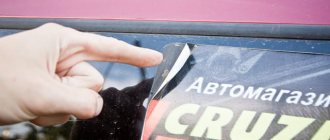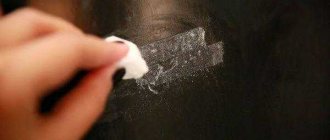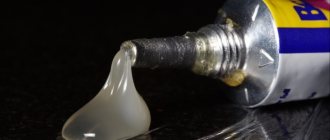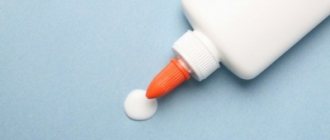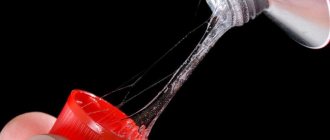How to remove glue from a sticker from plastic
Peeling off a sticker without leaving a trace at home is quite simple.
To ensure that the label sticks tightly and does not come off, manufacturers use strong adhesive . Removing it is quite difficult; you will need auxiliary materials and chemicals.
A few simple remedies:
- Chemical solvent for paints and varnishes . The plastic is immersed in the solvent for 5-7 minutes. During this time, the adhesive base will completely soften and will not be sticky. Residues are removed with a plastic scraper. The procedure should be carried out with gloves, and upon completion, wash your hands thoroughly.
- Ethyl and medical alcohol . At the pharmacy you buy a solvent of 92 or 96%. It perfectly “removes” glue residues from plastic. To do this, dampen a clean rag and wipe the stain. After some time, the adhesive base curls up and dissolves. Residues are removed with a new, clean rag or washcloth.
- Acetone or nail polish remover . The solvent is applied using a small piece of cloth. Wait a few minutes until the label gets wet and remove it.
- Vegetable oil . Place an item with a sticker in the container with the product and wait 12-15 minutes. The base is impregnated with vegetable fats, after which it is easy to remove with a blade.
- Paste. Add a small amount of soda to the water until a thick mass is formed. It is applied for a few minutes, then removed with a washcloth or cloth along with the glue.
To quickly remove glue, use a technical aerosol. You can buy it at a hardware store.
How to remove an old label and remove traces of glue from plastic
If the label has remained on the plastic for a long time, easy methods will not help. In this case, you need to use more concentrated products. White spirit works great. Mix the solvent with water.
Use only a weak solution to avoid damaging the plastic coating. Soak a cotton pad in the resulting mixture and soak the adhesive base. Wait ten minutes and wipe the product with a damp cloth or napkin.
The special product WD 40 will help to effectively remove stickers from plastic products. This composition quickly penetrates and loosens the adhesive composition, disinfects and cleans. Typically, WD 40 is used to lubricate locks and various mechanisms, as well as to remove rust.
By the way, read how to remove rust at home here. However, the product is also suitable for removing labels from plastic.
WD 40 aerosol is sprayed at a distance of ten centimeters from the surface of plastic products and left for ten minutes, then remove the residue with a damp cloth.
Instead of this composition, you can use alcohol, acetone or nail polish remover. Apply the solution to a cotton pad and wipe the pasted label, remove the residue with a blade or other sharp object, then wipe the product with a dry cloth.
After you remove the stickers, traces of glue may remain on the surface. This not only spoils the appearance of the product, but also contributes to the darkening of this area. In addition, dust and dirt will quickly stick to the sticky area. Peanut butter can remove traces of glue. Apply a little product on the sticky area, wait two to three minutes and then wash off with soap and water.
Masking or regular tape will 100% cope with sticker marks. Place the tape with the sticky side on the problem area and tear it off sharply. Then some of the glue will stick to the tape. Repeat the procedure with a new piece of tape until the remaining glue is completely removed.
How to remove label glue from glass
You should remove the sticker from glass objects before the first wash.
If the paper is difficult to remove, the following will help:
- Hair dryer. The procedure will take a few minutes. A hot air stream is directed onto the sticker. After a while it will begin to lag behind the glass. It is pryed off with a sharp object, and the glass or porcelain is washed in running water.
- Steam. The water is boiled and the glass container is held over the steam. The procedure lasts 5-7 minutes. The sticker peels off when exposed to hot air. When finished, rinse with hot water and soap.
- Boiling water. Soak cutlery with soap or detergent. When the label gets wet, remove it with a knife or metal sponge.
Read more ► How to adjust plastic windows so that they close tightly and do not blow in winter and summer
Baking soda will help at home - it can easily remove the sticker. To do this, apply a small amount of bicarbonate and remove it with a scraper.
How to remove stickers from glass and dishes
Essential oils, especially eucalyptus and tea tree oils, remove stickers and eliminate sticky residue from glass, tiles and ceramics. How to wash ceramic products, read the article about the rules for caring for ceramic tiles and porcelain stoneware.
Place a few drops of oil on a clean, dry cloth and wipe the dirty area. Then rinse the products with a composition for cleaning mirrors and glass, and finally wipe dry.
Vinegar and gasoline are only suitable for glass items. Apply a little of the selected product to a cotton pad, treat the surface and then remove the remaining label with a knife or other sharp object. Then wash the area with a damp cloth and wipe dry.
After the procedure, thoroughly wipe the surface with a solution for washing windows, glass and mirrors. Do not use brushes, rough or hard sponges to avoid scratching and damaging the glass. It is not recommended to use motor gasoline as it leaves streaks. Take a gasoline lighter.
For plastic utensils, you can use methods to clean plastic products. Essential oils are suitable for ceramic dishes; baking soda is suitable for porcelain and other types of materials.
In the latter case, a glass of soda is dissolved in a saucepan with hot water, where the product is lowered and left for half an hour. As a result, the label will fall off on its own. Remember that dishes with a label or sticker cannot be washed in the dishwasher!
How to remove stickers from dishes and porcelain
Removing the adhesive layer from dishes is quite difficult.
Removing the adhesive layer from dishes is quite difficult. At home you will need available materials.
Various options are used for this:
- Cologne. The alcohol solvent is applied using gauze or a cloth. Leave for 20 minutes. When the adhesive base gets wet, it is removed with dishwashing detergent. If there is no cologne in the house, use vodka.
- Vegetable oil . The dishes are soaked in water for several minutes, the sticky part is greased. Leave for one hour. Residues are removed with a washcloth and washed under water. The oil is washed off with cleaning powder or detergent.
- Vinegar. The dishes are soaked in vinegar and removed for one hour. Afterwards, the sticker is removed with a scraper, and the porcelain or glass is thoroughly washed.
You can remove glue from glass with a steel wool or knife. Don't be afraid to damage the surface. The dishes are “not afraid” of mechanical and chemical influence.
We use improvised means
It happens that stickers can be removed without difficulty, but this happens very rarely. Do not despair, because every home is full of improvised means that will help clean the surface of glue residues.
Fat (oil)
Sunflower oil is a good helper.
You can use any oil (butter or chemical). If you don’t have these products at home, use mayonnaise, sour cream or margarine. The essence of the method is that the listed fermented milk products contain fat, which is a glue solvent.
The product is spread on a dirty surface. Rinse off and clean the film 10 minutes after applying the product. You can remove traces of glue using a spatula or an unnecessary plastic card.
Alcohol
Alcohol is one type of product that can dissolve glue.
How to Clean a Label Using Alcohol:
- Pour alcohol onto a small cloth or swab.
- Place the compress on the label mark.
- After a few minutes, the remaining adhesive can be easily removed.
The wipes also contain alcohol, but in very small quantities. Therefore, if you scrub using a damp cloth, the result will not be obtained soon.
Acetic acid
Vinegar is often used as a solvent. To clean a contaminated surface, you do not need a highly concentrated product; it is enough to use 9% vinegar. Pour the liquid onto the cloth and apply it to the contaminated surface. After 10-15 minutes, rinse off the vinegar and remaining glue under running water.
It is not recommended to use this method on plastic dishes, as the material may deteriorate greatly.
Steam
Hot steam acts on the adhesive, allowing sticker residue to be quickly removed. You need to use a hot iron. This method is only suitable for heat-resistant cookware.
Eraser or melamine sponge
Special melamine eraser.
The eraser removes glue residue well. First, the vessel with the contaminated surface is placed in soapy water for 20 minutes. Then use an eraser or melamine sponge to wipe off the remaining glue. After all actions, rinse the tau.
Do not use on items that are easily scratched.
We wipe away traces with professional compounds
Below is a list of effective and safe glue solvents that do not harm dishes and are made from environmentally friendly materials.
- Anti-scotch. The product removes any dirt from the surface of the dishes. Consists of unique ingredients.
- Fine Glass. The product removes dirt from ceramic, glass and metal dishes.
- Scotch Remover. Removes resin and tar.
- Liqui Moly. It has a unique composition and is made from environmentally friendly materials.
The drugs effectively cope with their task. Their only drawback is their high cost.
Special drugs are expensive, but effective.
How to remove stickers from books
Buy a specialized stationery solution for paper. The
following will help you remove labels from a printed publication:
- Scotch. After removing the sticker, any remaining adhesive can be carefully removed using adhesive tape.
- Iron . The book is covered with a thick cloth and ironed. Under the influence of temperature, the label can be easily removed from the paper.
- Solvent. Use nail polish remover, but without acetone. The glue stain is wiped off with solvent. This method is suitable for glossy covers.
If these methods do not help , buy a specialized stationery solution for paper. It will easily remove the adhesive surface.
How to peel off a sticker from a soft surface
Manufacturers use barcode markings on the upholstered surface of furniture, fabric or finished textile products.
For cleaning, use special solvents or pure gasoline. The substances degrease the surface of the paper, after which the adhesive base is washed off with a soap solution.
Heat is used for fabric. The hairdryer is held for 7 minutes, then the sticker is removed with a knife. Use a clothes brush to remove any remaining glue and wash the fabric. The method is suitable for tablecloths, curtains and curtains.
Features of materials
Dishes are made from different materials: plastic, ceramics, metal, glass and so on. A label is attached to any product, since the manufacturer is required to label their product.
Buyers are faced with the fact that well-adhered stickers, after removal, leave an unsightly mark on new dishes. To deal with the problem, different cleaning methods for each type of material will be described below.
How to remove glue from plastic stickers
Cleaning plastic with a hair dryer.
Not every plastic utensil is resistant to high temperatures and chemicals; for this reason, you need to choose products based on these factors. You can clean it in the following ways:
- Mix baking soda with 2-3 drops of detergent. Apply this mixture to the contaminated area for 5 minutes.
- Use the hot air of a hair dryer to heat and easily peel off the sticker.
How to remove label glue from glass
Hot temperatures or chemicals will not harm glassware, but sharp or sharp objects may damage the surface of the glassware. For this reason, use safe cleansing methods:
- Apply a product containing grease to the contaminated surface. After this, rinse the product off the glass surface.
- Use solvent or vinegar.
- Soak the dishes in boiling water. Then, effortlessly wash off any remaining glue.
Heating is suitable for glass.
How to clean metal
Metal cleaning.
You can get rid of label marks on stainless steel in the following ways:
- Use a sharp object, such as a knife, to remove residue from the label.
- Heat the metal container to 100 degrees Celsius. After this, the sticker can be easily removed from the surface.
- Use solvents to quickly and effectively remove adhesive residue.
How to remove marks from fabric
After removing the sticker, traces of glue residue remain on clothing or furniture. Here are several ways to solve the problem:
- Wash the item. The glue will completely dissolve and disappear from the surface of the clothing.
- Use soapy water or alcohol.
Removing stickers from household appliances
You can remove stickers or labels from household appliances using a solvent, such as alcohol, vinegar, or a grease-containing product.
Removing stickers from different surfaces.
Stickers on cars and household appliances
Removing a label from a car is quite simple; for this you will need:
- household hair dryer;
- car cleaner;
- construction hairdryer (installed at gas stations and service stations).
Read more ► How to wash the outside of a window without streaks if it doesn’t open and you can’t reach it
When exposed to hot air, the paper peels off easily, and its sticky layer is removed with a plastic scraper . Do not use a metal sponge - it will scratch the car's paint.
Under the influence of hot air, the paper peels off easily, and its sticky layer is removed with a plastic scraper
To clean equipment use:
- oil: corn, olive, sunflower;
- cleaners;
- hairdryer
After completing the procedure, wash the devices with soapy water or dish soap. Cleaning methods that are used for plastic are also suitable for household appliances.
How to remove sticky adhesive from other materials?
To remove traces of glue, it is important to consider the material on which the sticker was glued. A variety of cleaning methods are used.
Tools used
The adhesive base can be removed manually using detergent.
If this does not help, then use:
- oil: sunflower, corn, olive;
- alcohol;
- vinegar;
- scotch;
- acetone;
- household hair dryer;
- citrus.
Oil
The method is suitable for surfaces that do not absorb fats.
Sequence of procedure:
- The label is soaked in oil and left for 10 minutes.
- Soaked paper is removed with a knife or plastic scraper.
- The product is washed with soap and water, and the remaining glue is removed.
If the house runs out of oil, you can take 20-40 g of mayonnaise.
Alcohol
Use pure homemade alcohol tincture
Use pure homemade alcohol tincture, store-bought vodka, deodorants.
Procedure:
- A cloth napkin is soaked in the composition.
- Wipe off the adhesive base.
- Rinse thoroughly with hot water.
This method is not suitable for all materials; you should first check it on an inconspicuous fragment.
Vinegar
Suitable for most surfaces, it does not contain “aggressive” chemicals.
Algorithm of actions:
- Apply table vinegar to a cloth.
- Wait 7-10 minutes: the paper will become limp during this time.
- Carefully remove the top layer.
- The glue is wiped with a wet cloth.
If the procedure does not help, repeat several times until the adhesive stain completely disappears.
Scotch
This method will help when the sticker is “fresh” and can be easily removed. Tape is glued to the top and torn off with a sharp movement.
The procedure is carried out several times, rinsing the remaining adhesive base with water.
Acetone
Solvent and a hair dryer will help in the fight against factory price tags. The label is heated with hot air and removed with a scraper. The remaining adhesive base is wiped off with a cloth soaked in acetone.
Hairdryer
Suitable for metal and durable materials.
Procedure:
- The surface is heated.
- They take off the price tag.
- Soak in oil or fat and leave for 10 minutes.
- Wash with detergent.
A household or hair dryer is suitable for warming up.
Citrus
You will need several lemons to remove the paper. The label is soaked in lemon juice and left for 10-20 minutes. The paper is removed with glue and washed with soap base.
Read more ► How to make window cleaner, recipe option at home
Removing stickers from clothes
Using an iron or hairdryer, heat the required area.
It is possible to remove price tags from items at home.
A few common options:
- Using an iron or hair dryer, heat the required area . A cloth is placed on the clothes so as not to spoil the surface. It is also necessary to read the composition of the fabric: some materials should not be subjected to heat treatment.
- Use nail polish remover without acetone. The sticker is carefully impregnated with it. But it’s worth checking first on an inconspicuous area of clothing, otherwise your favorite item may lose color.
- Clothes are placed in the freezer for 25-40 minutes. During this time, the glue “dries out” and the thermal pattern is easily removed by hand.
To remove the sticky layer, use tape, laundry soap and detergents.
From furniture and wood
The adhesive layer must be removed especially carefully if the furniture has a polished surface. Careless actions will lead to damage to interior items.
It is important to choose the right cleaning method:
- Heat treatment. The sticker is heated with a hairdryer for several minutes. The edge is lifted with a flat plastic object. Moisten a cloth with a polishing solution and wipe the surface of the furniture.
- Sunflower oil. The paper is moistened and left for several minutes. Scrub with a plastic object (knife). Furniture is wiped with soapy water.
- Aerosol . Spray on adhesive paper and leave for 2-3 minutes, then remove. It does not harm furniture and polishes the surface.
Old stickers are left for 10-15 minutes and soaked in alcohol.
From metal
Peeling the sticker off metal products without leaving a trace is not difficult. The methods listed above are suitable for this.
Means and materials for processing:
- hair dryer;
- vinegar;
- solvents;
- industrial products;
- oil;
- lemon juice.
- alcohol;
- alcohol.
The metal surface is durable and therefore difficult to damage.
Ways to remove sticky marks from a sticker
If the product is not susceptible to liquid treatment (for example, it is made of glass), then you can immerse it in warm water and leave it for a while. On average, 20-30 minutes are enough for the paper to completely soak, after which it can be easily removed from the surface of the product along with the sticky layer. As a rule, no traces of the sticker remain. But if the stain still remains, you need to rub it with a soft brush or rag. In most cases, the adhesive layer can be removed quite easily.
For plastic, wooden, and metal surfaces, another method of removing sticker marks is more suitable: using vegetable oil. In this case, you need to moisten a cotton pad or the edge of a rag with oil and rub the stain with force. Soon the sticky fibers will begin to roll into larger pellets and completely disappear from the surface of the product. This method can only be used after removing the top paper layer from the sticker. The easiest way to do this is by first softening the paper with hot water.
Another way to remove a sticky stain is to use alcohol or vodka. Just rub it a little with a cotton pad dipped in any of these liquids, and the surface will become clean. There are special products for removing traces of stickers from leather, calico, and fabrics. For example, "UHU Etikettenloser" or "Label Off". They are applied to the stain with a brush or sprayed with a spray bottle.
